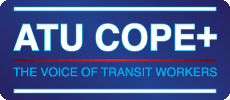A Militant History
Local 1700 of the Amalgamated Transit Union represents thousands of active and retired drivers, mechanics, terminal workers and other employees of Greyhound Lines. The recent history of Greyhound workers has been shaped largely by deregulation of the intercity bus industry, which was followed by two bitter strikes: the first in 1983, and the other during the early 1990s.
Greyhound began about 100 years ago as a shuttle between iron mines around Hibbing, Minnesota and became the largest intercity bus carrier in North America. As Greyhound took over smaller competitors, it also absorbed their drivers’ union locals, each with its own contract and work rules. Management took advantage of this disparity to weaken labor solidarity. The unions countered by affiliating with ATU and forming the Amalgamated Council of Greyhound Local Unions. Once there were more than 30 locals in the Council.
The intercity bus industry was strictly regulated from the time the Interstate Commerce Commission was established in 1935. In that heavily regulated business atmosphere, and with militant union solidarity, Greyhound drivers became the highest paid over the road drivers. But in 1982, Congress passed legislation that deregulated the business, ushering in an era of hyper competition, lax safety enforcement, and renewed union busting.
In November 1983, nearly 13,000 Greyhound drivers, mechanics, terminal and service workers were forced out of work and onto picket lines. By the time the strike ended 47 days later, union members had been forced to accept pay cuts, health care rollbacks and the elimination of pensions, and striker Ray Phillips had paid the ultimate price in the name of labor solidarity.
The 1983 Greyhound strike – along with then-President Ronald Reagan’s busting of the Professional Air Traffic Controllers Union earlier in his term – marked a turning point in U.S. labor relations. That was when employers went on the offensive against their workers to drive down the cost of labor and to increase profits.
The Amalgamated Council was forced to strike again in 1990 in a labor battle that became a bitter 39-month conflict that wasn’t settled until 1993. By then the company and union were shadows of their former selves. The following year, ATU International reorganized the Council as a nationwide local union, Local 1700, divided into six regions headed by Assistant Business Agents. The President, Executive Vice President, Financial Secretary/Treasurer, six ABAs, and an appointed representative for all Greyhound mechanics made up the ATU Local 1700 Executive Board.
Today, ATU Local 1700 represents some 3,500 active employees and about 300 retirees. Most members are Greyhound drivers and mechanics but we also represent Greyhound terminal workers in Florida, Georgia, Mississippi, Ohio, New York and California, as well as drivers at BoltBus in the North East and the drivers and mechanics at Southeastern Stages, based in Atlanta.
ATU Local 1700 has five basic functions:
1. Negotiate contracts with employers
2. Mobilize members
3. Organize new members
4. Educate members about issues affecting them on and off the job
5. Educate members about how our union functions and benefits them
ATU Local 1700 is chartered in the city of Chicago. Under Local 1700 bylaws, the president designates the meeting place for Charter City meetings. New York City is where Charter City membership meetings are held on the second Monday of each month.
Local 1700 has since reorganized members into four regions, each represented by an elected Vice President who designates a Sub-Charter City in his or her region. (After the reshuffle, members wanted to continue designating the Western U.S. as Region 5.) The current Sub-Charter Cities are:
• Region 1 – New York, NY
• Region 2 – Atlanta, GA
• Region 3 – Cleveland, OH
• Region 5 – Los Angeles, CA
Monthly Sub-Charter City membership meetings are held during the week after the Charter City meeting. Membership meetings in other cities are held whenever possible.







